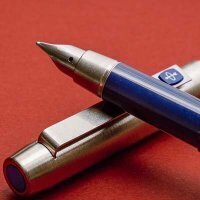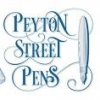Search the Community
Showing results for tags 'new old stock'.
-
I found this new old stock fountainpen at home with the original box. As far as I can tell, it was never used and it's in completely mint condition except for the box. Can anyone tell me is it worth anything?
- 2 replies
-
- montblanc
- monte rosa
-
(and 1 more)
Tagged with:
-
This Christmas brought a Parker 25: its packaging was opened, once, in January of 1977, so that the date could be added to the guarantee card, and then resealed with a bit of sellotape. Since then it hasn't been opened and remained unused until I found it on eBay, a couple of months ago. It's a Mark 1—flat cap-top, breather hole in the nib, recessed plastic lining in the section—but a later Mark 1, I think, as it has a brass thread in the body, rather than steel. It has a fine nib, from what I can tell by writing with it (although I've now swapped it for the definitely fine nib which came with the Mark 0, which has better ink flow). Anyway, since I've not seen this packaging anywhere else online, I thought people here might like to see it.
-
Hello- We've been selling new old stock 1970s Imperial II Deluxes for about 5 years now, and we've sold almost 2000 of them. Up until today, our supply had dwindled to fine nibs and only in grey and black. I'm happy to report we now have all 4 colors, and both fines and mediums. Touchdown filling systems (we replace the O-ring and test the pen with water, and when necessary we replace the sac)White Dot model with plastic barrels and brushed chrome capsShort Triumph conical nibs ... many have a bit of a "Waverly" up-tiltPriced at $48 with free US shipping (Intl, shipping is around $12)You'll find them here on the web site. http://www.peytonstreet.com/pens/sheaffer/imp2_med_burg_6.jpg http://www.peytonstreet.com/pens/sheaffer/imp2_med_blue_1.jpg Thanks! TERI
-
An exiting project. Restoring a lot of old and forgotten 1938 No Name German piston filling fountain pens. Recently I acquired a bunch of really old and dirty New Old Stock pens from Germany. I was told they were kept in an old trunk for more than 70 years and they were recently rediscovered when sold at an auction. At the bottom of the trunk was an old newspaper from Hamburg, 1944… It was difficult to determine the origin of the pens as they did not carry any brand or manufacturing mark except for a vague ‘EDEL – Chromstahl Qual.’ stamp on some of the nibs. Picture 1: Some of the pens in the lot as I found them http://img13.imageshack.us/img13/3951/knrq.jpg The rough finishing of the steel nibs indicated that they probably were made in the mid/end 1930’s (‘War nibs’; in that period the use of gold for instruments like fountain pens and nibs was prohibited by the German authorities). The caps and barrels were made of a material that at first resembled Bakelite, but it proved to be much softer and so I think the manufacturer used an early black thermo plastic, that was also used by other German manufacturers in that era, when they started looking for and develop new plastics that could replace the laborious hard rubber (Ebonite) and could be used in molding machines. Still, the sections, feeders and a part of the piston filling mechanisms were made of Ebonite and details showed that the majority of the parts were still hand (lathe) made in the traditional way of pen manufacturing of the late 20’s and early 30’s. Also the filling technique pointed to the mid 1930’s, the total design of the pens was obviously inspired by the new successful innovation of the piston filler pens by Pelikan, the model 100 in 1929. Picture 2: Pelikan 100 – 1929 ( Photo borrowed from ruetinger-web.de) http://img547.imageshack.us/img547/8089/fhuy.jpg Picture 3: Two of my (restored) No Name pens http://img853.imageshack.us/img853/4745/omcx.jpg All together, i think this was an interesting find, but also a tricky investment, because the pens were completely non usable in the condition I acquired them. They were very dirty and oxidized as a result of 70 years of bad storage. Some of the ‘gold’ plated iron clips had rust marks and, probably the worst problem, practically all the piston systems were completely stuck, probably due to shrinkage of the plastic barrel and filler mechanism parts. The fact that some of the pen parts were shrunken also indicated that the material was not Ebonite or Bakelite, but (thermo) plastic. So I decided to buy a modest amount of the total of several hundreds (!) of pens offered to me, to give myself the opportunity to have a sort of learning project to restore these old piston fillers. Furthermore I decided to disassemble and rebuild the pens one by one. To document the project I made a little photo report of the process of restoration. You can see pictures of the disassembling, the cleaning and re-polishing and finally the rebuilding of the pens. The problems with disassembling the piston mechanism were less difficult than I expected and the best of it was that most of the cork piston seals proved to be still in perfect condition. Some of the corks were damaged in the disassembly process, as in some cases they were stuck to the inside wall of the barrel, but in most cases the pistons came out with the complete and undamaged corks. Where for some pens the corks were broken, but the rest of the mechanism was still good, I decided to replace the corks with new, made to measure rubber seals. Another problem was the screw system that had to move the piston up and down. In most cases the inside screw was stuck in the hollow piston body, because the latter was shrunken and in some cases the piston screw (some made of a brittle zinc like metal, some of plastic) broke and in that case it was obviously end of story… But the other parts of these pens could be used as spare parts for the rest of the lot… Not all the nibs were in a usable condition. I readjusted and where possible reground the nibs that were not affected by rust, others I replaced by modern, new nibs I had in stock for general repair and restoring jobs. Pleasant surprise: The original nibs that could be (re)used proved to be extremely flexible! They were able to write a line variety from Medium to BBB! To be able to deliver enough ink for such a wide line I had to modify the feeders by widening the feeder channels. But as the feeders were just simple, classic ebonite friction mounted ones it was rather easy to widen the channels with a blade. After heat setting the nib/feeder combination the ink flow worked fine. Result: a bunch of nice, old fashioned Pelikan 100 style pens. Fully functional and some with a Super Flex nib! I obviously will keep some of the different varieties for myself and the rest will sooner or later turn up for sale, but that will be another story: check the classifieds in near future! Some pictures to show the process: Picture 4: One of the pens in the condition I found it in (without the dirt and the dust). http://img13.imageshack.us/img13/3413/04fo.jpg Picture 5: The ebonite piston filling systems were screwed in the plastic barrel. Due to shrinkage of the barrel the piston system was heavily stuck and I had to place it in a vice (protected by a piece of rubber gas hose) to hold it tight. http://img802.imageshack.us/img802/6580/vmjl.jpg Picture 6: Unscrew the piston system from the barrel with some force. http://img812.imageshack.us/img812/4279/om70.jpg Picture 7: The piston system unscrewed from the barrel. http://img268.imageshack.us/img268/1235/q57v.jpg Picture 8: The completely disassempbled pen. http://img853.imageshack.us/img853/648/wapo.jpg Picture 9: Polishing the rough ebonite of the section. http://img209.imageshack.us/img209/2749/ntl0.jpg Picture 10: That looks better! http://img716.imageshack.us/img716/1016/xu5s.jpg Picture 11: The piston with the perfectly preserved cork seal. Just needed a tiny dab of silicon grease. http://img15.imageshack.us/img15/139/rf8m.jpg Picture 12: Some silicon grease to the treading of the piston system. http://img801.imageshack.us/img801/203/jdxz.jpg Picture 13: The piston seal viewed trhough the cleaned and polished ink window. Cap thread still needs some more cleaning. http://img842.imageshack.us/img842/5609/ykfc.jpg Picture 14: Heating the Ebonite feeder with the heat gun (on half power…) http://img405.imageshack.us/img405/2961/y8mc.jpg Picture 15: Setting the warm, softened feeder to the nib. http://img29.imageshack.us/img29/926/i74z.jpg Picture 16: I made some small disc grinders to fit on my mini lathe. This one with micromesh 8000 to smooth out nibs easily. http://img96.imageshack.us/img96/7184/d1a9.jpg Picture 17: Smoothing the steel nib very carefully as it had just a tiny bit of iridium. http://img196.imageshack.us/img196/103/98hv.jpg Picture 18: Final polishing of the pen body. The difference between the brownish part of the piston system and the shiny raven black plastic is clearly visible. Because of the ribbed form it was not possible to polish out the rough surface and the discoloration of the ebonite. http://img203.imageshack.us/img203/3936/f2td.jpg Picture 19: Working on the cap. Because of the relatively high speed of the lathe machine one has to take a lot of care with the developing heat when polishing. http://img28.imageshack.us/img28/5836/drje.jpg Picture 20: I only use very light pressure and a thin cloth so I can feel the temperature rising and stop in time. http://img823.imageshack.us/img823/2299/fgim.jpg Picture 21: Polishing the tarnished clip. http://img96.imageshack.us/img96/4630/a69x.jpg Picture 22: Re assembling the cap. http://img405.imageshack.us/img405/15/9t95.jpg Picture 23: Removing the last bit of debris from the cap tread on the barrel. http://img9.imageshack.us/img9/8010/8lz1.jpg Picture 24: The completely reassembled pen http://img850.imageshack.us/img850/8460/ov6m.jpg Picture 25: A classic vintage beauty http://img404.imageshack.us/img404/414/p776.jpg Picture 26: Nib adjusted and filled up with Akkerman Shocking Blue: A surprising writing result, with a flex medium to triple B line. http://img10.imageshack.us/img10/5018/anzc.jpg All pictures uploaded with ImageShack.us Hope you enjoyed the report, please comment, Lex aka LEXAF
- 41 replies
-
- new old stock
- restoring
-
(and 2 more)
Tagged with:
-
This label came with a NOS Sailor pen I just got. The pen itself is black plastic, slim, with goodtone cap and semi-hooded xf nib. Other than the yen amount I don't trust my shaky translation. Can anyone tell me what it says? Thanks! http://extras.ourpatioparty.com/files/5014/0546/7336/Sailor_Pen_Label001.jpg
-
Poorly documented, largely overlooked The Eversharp Symphony was launched in 1948 and couldn't have had a more auspicious beginning. While the company's previous major model, the Fifth Avenue, had some shortcomings that prevented it from catching on with the public, the company hoped to reproduce some of the success enjoyed by the iconic Skyline model which had achieved sales superiority in the mid 1940s. The Skyline had been designed by famous industrial designer Henry Dreyfuss, and for the Symphony the company went to another famous consumer-goods designer, Raymond Loewy. The first generation Symphony pens (aka model 500) can be partially distinguished by the raised fins on the chrome cap, the brushed stainless steel cap finish with no cap band, and the metal barrel threads. The raised fins create the impression of the cap being sliced lengthwise, and then offset slightly, giving the cap its "slipper" name. The first generation pens were only produced for a year. The second generation simplified some of the Loewy design. Model 701 came out in 1949 and can be identified by the thin gold plated cap band embedded in a shiny stainless steel cap. Additionally, a few new models were added to the product line. The 703 (the "Deluxe" Symphony, photo below) featured a wide gold plated cap band, and the "Golden Symphony" (model 705) had a gold filled cap. A "Luxury" version was created for the bottom level of the product line; hardly luxurious, it featured cheap gold plating and a rounded cap entirely lacking fins. http://www.peytonstreet.com/PSP/blog/symphony_deluxe_set_250.jpg Then came the third version circa 1951. Taking a cue from the "Luxury" pens, the caps lacked the finned design entirely. Documentation indicates a new model was introduced, the "Economy Gold Nib" set, and it is believed to be an all-plastic model. Right around this time Eversharp stopped using the Symphony name, and the pens are frequently found in ads under the name "The NEW Eversharp." Basically, this is where the trail goes cold. Digging a little deeper .... In our new old stock acquisitions we have found several models which share the Symphony shape, nib and filling system, but lack the metal cap which many consider to be a characteristic of the Symphony line. Here's what we've found: Model 713 -- plastic body and cap, thin gold plated cap band, gold plated clip. Small flexible nib. http://www.peytonstreet.com/PSP/blog/713_500.jpg Model 913 -- plastic body and cap, thin chrome plated cap band, chrome plated clip. Small flexible nib. http://www.peytonstreet.com/PSP/blog/913_500.jpg Model ??? -- same as the 713 only lacking a metal cap band, having instead a series of grooves in the plastic where you'd find the cap band. Small flexible nib. http://www.peytonstreet.com/PSP/blog/symphony_linedband_black_500.jpg Model 915 -- same as 913 except with a wider (3/16") lined chrome band. Medium sized nib, the same one as is found on the 701, in both flexible and manifold. http://www.peytonstreet.com/PSP/blog/symphony_915_500.jpg Model 917 -- same as the 913 and 915, only with a very wide chrome cap band. This model featured a larger banner-style Eversharp nib, in both manifold and flexible versions. http://www.peytonstreet.com/PSP/blog/symphony_917_green_500.jpg By 1952, the Symphony and quasi-Symphony pens disappeared from Eversharp's product line as they gave their attention to the Ventura model. We have a feeling that a large quantity of the low end Symphony pens were more or less abandoned out in the distribution channel, especially outside the US, and those are probably the models that we have discovered. Another theory holds that when Parker gobbled up Eversharp in 1957, they continued to produce low end pens under the Eversharp name to use up the surplus of parts, and these may very well be some of those pens. We're hoping that this post will bring more information to light. Surely there must be folks who worked at Eversharp in the 1950s and 1960s, and who will be able to poke holes in our theories and tell us more about these late-late-late model Eversharps.
- 6 comments
-
- wahl eversharp
- eversharp symphony
-
(and 2 more)
Tagged with:

.thumb.jpg.ba969e619d5b9afe95898860d6762814.jpg)
















